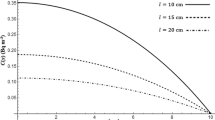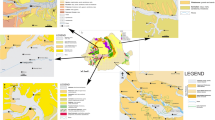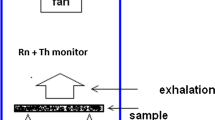Abstract
A theoretical method is used to calculate the radon exhalation and flux from the walls of a room and the soil to the living space in the room. The calculations are based on the Fick’s laws to describe the radon diffusion through the walls and in the soil. In both cases, the diffusion is considered as one-dimension along the direction to the inside of the room. Under some conditions, the three-dimensional diffusion has to be taken into account. A comparison between the one- and three-dimensional descriptions is discussed, and hence the radon areal release rate from a wall and that from a construction material sample are formulated and related. Consequent indoor radon concentrations and inhalation doses are represented. The effect of the radon release from the construction materials on calculating the gamma dose rate in a room is studied.








Similar content being viewed by others
References
V. Druzhinin, M.Y. Sinitsky, A.V. Larionov, V.P. Volobaev, V.I. Minina, T.A. Golovina, Assessing the level of chromosome aberrations in peripheral blood lymphocytes in long-term resident children under conditions of high exposure to radon and its decay products. Mutagenesis 50(5), 677–683 (2015)
M. Al-Zoughool, D. Krewski, Health effects of radon: a review of the literature. Int. J. Radiat. Biol. 85, 57–69 (2009)
A citizen’s guide to radon, United States Environmental Protection Agency. https://www.epa.gov/. Accessed 24 Jan 2020
J. Tong, L. Qin, Y. Cao, J. Li, J. Zhang, J. Nie, Y. An, Environmental radon exposure and childhood Leukemia. J. Toxicol. Environ. Health 15(5), 332–347 (2012)
J.S. Puskin, Smoking as a confounder in ecologic correlations of cancer mortality rates with average county radon levels. Health Phys. 84, 526–532 (2003)
F. Bochicchio, Radon epidemiology and nuclear track detectors: methods, results and perspectives. Radiat. Meas. 40, 177–190 (2005)
B.L. Cohen, Test of the linear no-threshold theory of radiation carcinogenesis for inhaled radon decay products. Health Phys. 68, 157–174 (1995)
European Commission, Luxembourg: enhanced radioactivity of building materials. Radiation Protection 96, 1 (1999)
G. Keller, B. Hoffmann, T. Feigenspan, Radon permeability and radon exhalation of building materials. Sci. Total Environ. 272, 85–89 (2001)
K. Kovler, A. Perevalov, V. Steiner, E. Rabkin, Determination of the radon diffusion length in building materials using electrets and activated carbon. Health Phys. 86, 505–516 (2004)
R.P. Chauhan, A. Kumar, A comparative study of indoor radon contributed by diffusive and advective transport through intact concrete. Phys. Procedia 80, 109–112 (2015)
Y. Hafez, E. Awad, Finite element modeling of radon distribution in natural soils of different geophysical regions. Cogent Phys. 3, 1254859 (2016)
UNSCEAR. United Nations Scientific Committee on the Effects of Atomic Radiations sources, effects and risks of ionizing radiation. United Nations, New York (2000)
S. Stoulos, M. Manolopoulou, C. Papastefanou, Assessment of natural radiation exposure and radon exhalation from building materials in Greece. J. Environ. Radioact. 69, 225–240 (2003)
P. Ujic, I. Celikovic, A. Kandic, I. Vukanac, M. Durasevic, D. Dragosavac, Z. Zunic, Internal exposure from building materials exhaling 222Rn and 220Rn as compared to external exposure due to their natural radioactivity content. Appl. Radiat. Isot. 68, 201–206 (2010)
Y. Li, C. Fan, M. Xiang, P. Liu, F. Mu, Q. Meng, W. Wang, Short-term variations of indoor and outdoor radon concentrations in a typical semi-arid city of Northwest China. J. Radioanal. Nucl. Chem. 317(1), 297–306 (2018)
K. Ivanova, Z. Stojanovska, B. Kunovska, N. Chobanova, V. Badulin, A. Benderev, Analysis of the spatial variation of indoor radon concentrations (national survey in Bulgaria). Environ. Sci. Pollut. Res. 26, 6971–6979 (2019)
Author information
Authors and Affiliations
Corresponding author
Rights and permissions
About this article
Cite this article
Orabi, M. Calculating the indoor radon flux from construction materials and soil. Eur. Phys. J. Plus 135, 458 (2020). https://doi.org/10.1140/epjp/s13360-020-00483-9
Received:
Accepted:
Published:
DOI: https://doi.org/10.1140/epjp/s13360-020-00483-9




